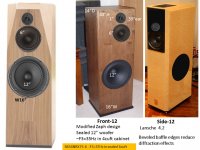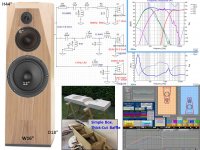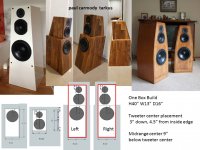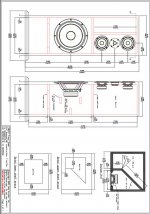I have given up my previous endeavour of trying to duplicate an old Wharfedale design and beginning to think that building an existing tried and tested setup might be the way to go.
The brief: I use a Sony ES integrated amp of 80wpc.
Source music will be CD and vinyl, Rock, Blues, and Jazz
Room size is approx. 36 sq metres
Wife doesn't care how large or ugly the enclosures are
I enjoy a fair bit of bass but clean and defined, not muddy.
Due to age my treble awareness is pretty much topped out at
10khz so ultra high capability tweeters would be a bit of a waste.
I can handle any woodworking challenges easily apart from curves.
Can anyone recommend a design that might be suitable?
Hopefully not requiring drivers costing over €100 a pop.
The brief: I use a Sony ES integrated amp of 80wpc.
Source music will be CD and vinyl, Rock, Blues, and Jazz
Room size is approx. 36 sq metres
Wife doesn't care how large or ugly the enclosures are
I enjoy a fair bit of bass but clean and defined, not muddy.
Due to age my treble awareness is pretty much topped out at
10khz so ultra high capability tweeters would be a bit of a waste.
I can handle any woodworking challenges easily apart from curves.
Can anyone recommend a design that might be suitable?
Hopefully not requiring drivers costing over €100 a pop.
Last edited:
Thanks for the suggestions. I have seen the Tarkus before. The Peerless drivers would certainly be within my budget.
Due to the lack of high frequency requirements maybe a simple 2 way with a 15" pro driver and a 2" CD / horn crossed around 800Hz could suit you well.
Rob.
Rob.
Something tells me you would appreciate a larger front baffle, not a narrow speaker.old Wharfedale design
how large or ugly the enclosures are
I enjoy a fair bit of bass but clean and defined,
I have seen the Tarkus before. The Peerless drivers would certainly be within my budget.
There are a few Tarkus adaptations which use a single easy to build cabinet. Just Google Tarkus speaker images or visit Paul Carmondy's website.
=========
The SB Acoustics website has free documentation of a few diy kits.
For a basic cost comparison with the Peerless Tarkus, a 3-way SB Acoustics in a W15" x H42" x D14" cabinet(3cuft) simple beveled baffle cabinet.
SB_Acoustics drivers = $253/speaker, with crossover estimate $300/speaker
$33____1" tweeter___SB26STCN-4
$72____6.5" midrange ___SB17MFC35-8
$148____10” SB29NRX75-6
This speaker would make Miles Davis smile 😎
A sealed box woofer can produce superior tight Qtc=0.5 - 0.7 bass transients, but physics requires a reduced efficiency compared to a ported woofer alignment. SB Acoustics engineers designed the 12" SB34NRX75-6 woofer to produce sealed box bass down to -F3 ~ 36 Hz in a 3.5cuft cabinet volume. USA designer ZAPH praised this driver in his SB 12.3 speaker design(MTM+ 12"woofer). An Avalon-style truncated pyramid is the ideal low diffraction cabinet, but you can adapt ZAPH's documented SB12.3 cabinet, or put the woofer on the side panel of a narrow front baffle design with simple edge bevels.
12" SEALED WOOFER: SB_Acoustics drivers = $277/speaker, with crossover estimate $330/speaker
$33____1" tweeter___SB26STCN-4
$72____6.5" midrange ___SB17MFC35-8
$172____12” SB34NRX75-6 optimized for sealed performance
The woodshop capabilities often determines the speaker design.
A sealed box woofer can produce superior tight Qtc=0.5 - 0.7 bass transients, but physics requires a reduced efficiency compared to a ported woofer alignment. SB Acoustics engineers designed the 12" SB34NRX75-6 woofer to produce sealed box bass down to -F3 ~ 36 Hz in a 3.5cuft cabinet volume. USA designer ZAPH praised this driver in his SB 12.3 speaker design(MTM+ 12"woofer). An Avalon-style truncated pyramid is the ideal low diffraction cabinet, but you can adapt ZAPH's documented SB12.3 cabinet, or put the woofer on the side panel of a narrow front baffle design with simple edge bevels.
12" SEALED WOOFER: SB_Acoustics drivers = $277/speaker, with crossover estimate $330/speaker
$33____1" tweeter___SB26STCN-4
$72____6.5" midrange ___SB17MFC35-8
$172____12” SB34NRX75-6 optimized for sealed performance
The woodshop capabilities often determines the speaker design.
Attachments
"Due to the lack of high frequency requirements maybe a simple 2 way with a 15" pro driver and a 2" CD / horn crossed around 800Hz could suit you well.
Rob."
Did you have a proven design in mind?
"Something tells me you would appreciate a larger front baffle, not a narrow speaker."
I've got plenty of space and an understanding wife.
"The Tarkus is on my "To Build" list.
If not the Tarkus a clone using the Peerless 12inch sealed"
A larger bass driver is appealing to me but I don't have the brain power to rejig the crossover to make it work. Even with the help of free design software I just get tied up in knots, not to mention the conflicting advice and downright discouragement available on forums.
Rob."
Did you have a proven design in mind?
"Something tells me you would appreciate a larger front baffle, not a narrow speaker."
I've got plenty of space and an understanding wife.
"The Tarkus is on my "To Build" list.
If not the Tarkus a clone using the Peerless 12inch sealed"
A larger bass driver is appealing to me but I don't have the brain power to rejig the crossover to make it work. Even with the help of free design software I just get tied up in knots, not to mention the conflicting advice and downright discouragement available on forums.
There are a few Tarkus adaptations which use a single easy to build cabinet. Just Google Tarkus speaker images or visit Paul Carmondy's website.
=========
The SB Acoustics website has free documentation of a few diy kits.
For a basic cost comparison with the Peerless Tarkus, a 3-way SB Acoustics in a W15" x H42" x D14" cabinet(3cuft) simple beveled baffle cabinet.
SB_Acoustics drivers = $253/speaker, with crossover estimate $300/speaker
$33____1" tweeter___SB26STCN-4
$72____6.5" midrange ___SB17MFC35-8
$148____10” SB29NRX75-6
All suggestions would probably hit my target well, particularly the Zaph 12.3 design which is very similar to the Wharfedale I was trying to clone, but.....................
The prices for the wonderful SB Acoustics drivers push all these ideas into "when I win the lottery" land.
Last edited:
"Due to the lack of high frequency requirements maybe a simple 2 way with a 15" pro driver and a 2" CD / horn crossed around 800Hz could suit you well.
Rob."
Did you have a proven design in mind?
Unfortunately not (I use a digital crossover so it's fairly easy for me to get a 2 way playing ) I have used P Audio 2" drivers with my jbl 15's and it worked well.
Another option you could look into is buying a used pair of good PA speakers and making some decent well braced / nice looking cabs for them. Use the existing crossovers and pay attention to flushing the horn / driver into the baffle, rounding over the baffle edges etc to 'hi fi' them up a bit.
Rob.
Have you found good pricing for the Tarkus parts + shipping?
You could build a simple single box cabinet with the midrange and tweeter offset to the inside edge to best match the initial crossover design for the center soundstage diffraction effects. With this mirror'ed TM construction, you can also later swap L<-->R to compare soundstage quality with reduced wall reflections from edge diffraction.
Study the ZAPH SB12.3 cabinet construction with similar baffle layout. Note how ZAPH created a sealed triangular volume behind the midrange to reduce resonance effects. Use similar bracing: 2-horizontal shelf braces + 1-vertical sealed box brace to create mid-tweet volume.
If you can cut good 45-degree edge joints, you may find the cost of plywood + matte finish acrylic urethane is not much greater than MDF plus the complex joint sealing, priming, and painting.
The woodshop capabilities often determines the speaker design.
You could build a simple single box cabinet with the midrange and tweeter offset to the inside edge to best match the initial crossover design for the center soundstage diffraction effects. With this mirror'ed TM construction, you can also later swap L<-->R to compare soundstage quality with reduced wall reflections from edge diffraction.
Study the ZAPH SB12.3 cabinet construction with similar baffle layout. Note how ZAPH created a sealed triangular volume behind the midrange to reduce resonance effects. Use similar bracing: 2-horizontal shelf braces + 1-vertical sealed box brace to create mid-tweet volume.
If you can cut good 45-degree edge joints, you may find the cost of plywood + matte finish acrylic urethane is not much greater than MDF plus the complex joint sealing, priming, and painting.
The woodshop capabilities often determines the speaker design.
Attachments
There is a category of 15" + waveguided tweeter which is very successful amongst DIYers.A larger bass driver is appealing to me but
There is a project out there to match actual drivers and easily obtainable parts with appropriate crossovers. It is by a contributor named Zilchlab (known as Zilch elsewhere). The project is called Econowave. An example would be the first photo in this thread.
This is a closer to ideal implementation.
A simulator is a powerful tool but it won't teach you to design a crossover. Few people can use one and get the best out of a speaker.not to mention the conflicting advice and downright discouragement available on forums.
Last edited:
I can suggest a design possibility that wouldn't be too hard to implement. Based on the DIY Audio 2-Way reference speaker project. But it won't play earth shatteringly loud.
The Vifa P-13 coming out of China are pretty good now and consistent it seems. Build a version of that and add a .5 woofer
All that takes is a reasonably big inductor
OR
Possibly a pair of .5 woofers with different roll-off frequencies; one at the point where the P-13 goes 3dB down and another at or around baffle step
Single woofer use 12" Dual woofers use a couple of 8s or 10s
The Vifa P-13 coming out of China are pretty good now and consistent it seems. Build a version of that and add a .5 woofer
All that takes is a reasonably big inductor
OR
Possibly a pair of .5 woofers with different roll-off frequencies; one at the point where the P-13 goes 3dB down and another at or around baffle step
Single woofer use 12" Dual woofers use a couple of 8s or 10s
Have you found good pricing for the Tarkus parts + shipping?
Yes. The best I can find is a choice between a UK supplier with free delivery to a friend there who comes over to France a couple of times a year, or another source in France that would charge extra for delivery making them more expensive. The Tarkus option could be an option if I can sell off some tools to raise some extra cash.
You could build a simple single box cabinet with the midrange and tweeter offset to the inside edge to best match the initial crossover design for the center soundstage diffraction effects. With this mirror'ed TM construction, you can also later swap L<-->R to compare soundstage quality with reduced wall reflections from edge diffraction.
I am loathe to alter anything from an original proven design because I have no way to determine any bad effects.
Study the ZAPH SB12.3 cabinet construction with similar baffle layout. Note how ZAPH created a sealed triangular volume behind the midrange to reduce resonance effects. Use similar bracing: 2-horizontal shelf braces + 1-vertical sealed box brace to create mid-tweet volume.
If you can cut good 45-degree edge joints, you may find the cost of plywood + matte finish acrylic urethane is not much greater than MDF plus the complex joint sealing, priming, and painting.
The woodshop capabilities often determines the speaker design.
Being a retired boat builder These simple structures in ply will not be difficult. Lack of space and a temperature controlled workspace prevents me doing anything requiring laminating curves, etc. but cubes, triangles, & odd shaped boxes with flat sides are no problem. I will be building with the best quality ply I can find and not skimp on the thickness.
A simulator is a powerful tool but it won't teach you to design a crossover. Few people can use one and get the best out of a speaker.
I have come to learn that the hard way. Another lesson learned is how totally useless an off the peg crossover is. Apparently a crossover only works correctly when designed for a given set of drivers in a specified enclosure. I haven't a clue why they even sell them. Lesson learned=money wasted.
My learning curve has been too tedious to continue. That is why I am looking at building a proven design. The trouble is deciding which components to start buying first. My project will take quite a while buying the drivers when cash is available. My worry is that a driver will become unavailable by the time I try to buy it. And some designs the crossover parts list leaves a bit of guesswork regarding wattage of resistors, etc. Although I have had a lot of experience with point to point and pcb wiring and can read a schematic I don't have the engineering knowledge for initial design or final tweaking.
There is a category of 15" + waveguided tweeter which is very successful amongst DIYers.
There is a project out there to match actual drivers and easily obtainable parts with appropriate crossovers. It is by a contributor named Zilchlab (known as Zilch elsewhere). The project is called Econowave. An example would be the first photo in this thread.
This is a closer to ideal implementation.
A simulator is a powerful tool but it won't teach you to design a crossover. Few people can use one and get the best out of a speaker.
+1 for 2 way with horn!
Step 1, hear a decent horn system and see if the sound is for you. It's different, but i prefer it so much to my direct radiators that I'm sure ill never build another conventional 2/3 way direct radiator. Give some a listen.
Not so easy, friend. I live in rural France. I haven't met anyone yet who gives a toss about decent quality audio, let alone owns something so specialised.
+1 for 2 way with horn!
Step 1, hear a decent horn system and see if the sound is for you. It's different, but i prefer it so much to my direct radiators that I'm sure ill never build another conventional 2/3 way direct radiator. Give some a listen.
😕 sorry but it seems that only the high frequencies are "horned" in that kind of speaker, so I wonder why so much enthusiasm ?!
I follow most of the threads regarding single speaker, 2, 3 way and active Vs. passive etc and constant directivity, mono-di-pole, cardioid, more/less diffusion/reflection and regarding sound...yes, you ought to find the sound that pleases you by any means, be it EQed, absorbed, refracted etc etc and yes! the altec VOTT represents some kind of "horned" two way but limited by the area of the mouth, but don't forget room gain, DI, amplification...

Don't worry because the best crossovers are point-to-point and most important they are external! Just take the wires out of the boxes ( about 1m) and from the amplifier ( about 1 m).And some designs the crossover parts list leaves a bit of guesswork regarding wattage of resistors, etc. Although I have had a lot of experience with point to point and pcb wiring and can read a schematic I don't have the engineering knowledge for initial design or final tweaking.
- Status
- Not open for further replies.
- Home
- Loudspeakers
- Multi-Way
- Design suggestions



